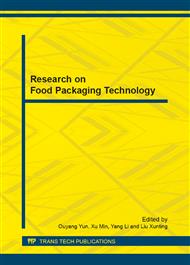[1]
Kramer and B Twigg,. Measure of frozen food quality and quality changes. In The freezing preservation of foods, 4th Ed., Vol. 2, D. K. Tressler(ed), AVI pub. Co., Westport, Conn, (1968).
Google Scholar
[2]
P.S. Taoukis and T. P Labuza, Time-temperature indicators(TTIS). In: Ahvenainen, R. (Ed. ) Novel Food Packaging Techniques. Woodhead Publishing Ltd., Cambridge. (2003), pp.103-126.
DOI: 10.1533/9781855737020.1.103
Google Scholar
[3]
J.N. Smith, Specialized logistics for a longer perishable supply chain. World Trade, (2005), p.18, 46-48.
Google Scholar
[4]
V. Raab, , S. Bruckner, E. Beierle, et al., Generic model for the prediction of remaining shelf life in support of cold chain management in pork and poultry supply chains. Journal on Chain and Network Science, 8(2008), pp.59-73.
DOI: 10.3920/jcns2008.x089
Google Scholar
[5]
G Betts,. and L. Everis, Shelf-life determination and challenge testing. In: Chilled Foods: A Comprehensive Guide (edited by G. Betts & L. Everis). Cambridge: Woodhead Publishing Limited. ( 2000), pp.259-285.
DOI: 10.1201/noe0849308567.ch10
Google Scholar
[6]
J. Moureh, , O. Laguerre, D. Flick, and B. Commere,. Analysis of use of insulating pallet covers for shipping heat-sensitive foodstuffs in ambient conditions. Computers and Electronics in Agriculture, 34(2002), pp.89-109.
DOI: 10.1016/s0168-1699(01)00181-8
Google Scholar
[7]
M.C. Giannakourou, K. Koutsoumanis, G.J.E. Nychas, P.S. Taoukis., Field evaluation of the application of time temperature integrators for monitoring fish quality in the chill chain. International Journal of Food Microbiology, 102 (2005).
DOI: 10.1016/j.ijfoodmicro.2004.11.037
Google Scholar
[8]
P. S Taoukis and TP Labuza. Reliability of time temperature indicators as shelf life monitors of food products. J Food Sci, 54(1989). pp.783-788.
DOI: 10.1111/j.1365-2621.1989.tb07882.x
Google Scholar
[9]
R. Grisius, J.H. Well, E. L Barret, R. P Singh,. Correlation of time-temperature indicator response with microbial growth in pasteurized milk. Journal of Food Processing and Preservation, 11(1987), p, 309-324.
DOI: 10.1111/j.1745-4549.1987.tb00057.x
Google Scholar
[10]
R.P. Singh, , J.H. Wells, Use of time-temperature indicators to monitor quality of frozen hamburger. Food Technology, 39(1985), pp.42-45.
Google Scholar
[11]
M.C. Giannakourou, P.S. Taoukis. Application of a TTI-based distribution management system for quality optimization of frozen vegetables at the consumer end. Journal of Food Science, 68 (2003), p.201–209.
DOI: 10.1111/j.1365-2621.2003.tb14140.x
Google Scholar
[12]
M. Rokka, S. Eerola, M. Smolander, H.L. Alakomi, R. Ahvenainen. Monitoring of the quality of modified atmosphere packaged broiler chicken cuts stored in different temperature conditions: B. Biogenic amines as quality-indicating metabolites. Food Control, 15 (2004).
DOI: 10.1016/j.foodcont.2003.10.002
Google Scholar
[13]
M. Smolander, H.L. Alakomi, T. Ritvanen, J. Vainionpää, R. Ahvenainen. Monitoring of the quality of modified atmosphere packaged broiler chicken cuts stored in different temperature conditions: A. Time–temperature indicators as quality-indicating tools. Food Control, 15 (2004).
DOI: 10.1016/s0956-7135(03)00061-6
Google Scholar
[14]
B. Bobelyn, M.L.A.T.M. Hertog, B.M. Nicolaï. Applicability of an enzymatic time temperature integrator as a quality indicator for mushrooms in the distribution chain. Postharvest Biology and Technology, 42 (2006) , pp.104-114.
DOI: 10.1016/j.postharvbio.2006.05.011
Google Scholar
[15]
M. Nuin, B. Alfaro, Z. Cruz, N. Argarate, S. George, Y. Le Marc, J. Olley, C. Pin. Modelling spoilage of fresh turbot and evaluation of a time–temperature integrator (TTI) label under fluctuating temperature. International Journal of Food Microbiology, 127(2008).
DOI: 10.1016/j.ijfoodmicro.2008.04.010
Google Scholar
[16]
T. Tsironi, E. Gogou, E. Velliou, P.S. Taoukis. Application and validation of the TTI based chill chain management system SMAS (Safety Monitoring and Assurance System) on shelf life optimization of vacuum packed chilled tuna. International Journal of Food Microbiology, 128 (2009).
DOI: 10.1016/j.ijfoodmicro.2008.07.025
Google Scholar
[17]
H. Vaikousi, C.G. Biliaderis, K.P. Koutsoumanis. Applicability of a microbial Time–Temperature Indicator (TTI) for monitoring spoilage of modified atmosphere packed minced meat. International Journal of Food Microbiology, 133 (2009), pp.272-278.
DOI: 10.1016/j.ijfoodmicro.2009.05.030
Google Scholar
[18]
M. Ellouze, J.C. Augustin. Applicability of biological time temperature integrators as quality and safety indicators for meat products. International Journal of Food Microbiology, 138 (2010), pp.119-129.
DOI: 10.1016/j.ijfoodmicro.2009.12.012
Google Scholar
[19]
Wu D, Wang Y, Chen J, et al. Preliminary Study on time-temperature indicator (TTI) system based on urease. Food Control, 34(2013), P. 230-234.
DOI: 10.1016/j.foodcont.2013.04.041
Google Scholar
[20]
Lu L, Zheng W, Lv Z, et al. Development and Application of Time–temperature Indicators Used on Food during the Cold Chain Logistics[J]. Packaging Technology and Science, 26(2013), pp.80-90.
DOI: 10.1002/pts.2009
Google Scholar
[21]
Nopwinyuwong, A., et al. Preparation of Polydiacetylene Vesicle and Amphiphilic Polymer as Time-Temperature Indicator., Advanced Materials Research, 506 (2012), pp.552-555.
DOI: 10.4028/www.scientific.net/amr.506.552
Google Scholar
[22]
Mai N, Audorff H, Reichstein W, et al. Performance of a photochromic time–temperature indicator under simulated fresh fish supply chain conditions. International Journal of Food Science & Technology, 46(2011), pp.297-304.
DOI: 10.1111/j.1365-2621.2010.02475.x
Google Scholar
[23]
W. Chahattuche, H. Vipa, S. Panuwat. Development and characterization of a prototype of alacticacid–basedtime–temperatureindicator for monitoring food product quality. Journal of Food Engineering. 100(2010), pp.427-434.
Google Scholar
[24]
J. Kreyenschmidt, H Christiansen, A Hübner, et al. A novel photochromic time–temperature indicator to support cold chain management[J]. International Journal of Food Science & Technology, 45(2010), pp.208-215.
DOI: 10.1111/j.1365-2621.2009.02123.x
Google Scholar
[25]
Wang, JinPeng, et al. Konjac Glucomannan as a Carrier Material for Time—Temperature Integrator., Food Science and Technology International 16(2010), pp.127-134.
Google Scholar
[26]
S. Yan, C. Huawei, Z. Limin, R. Fazheng, Z. Luda, Z. Hengtao. Development and characterization of a new amylase type time–temperature indicator. Food Control, 19 (2008), pp.315-319.
DOI: 10.1016/j.foodcont.2007.04.012
Google Scholar
[27]
M F.F. Poças, T.F. Delgado, F.A.R. Oliveira. Smart packaging technologies for fruits and vegetables. J. Kerry, P. Butler (Eds. ), Smart Packaging Technologies, John Wiley and Sons Ltd., West Sussex. (2008), pp.151-166.
DOI: 10.1002/9780470753699.ch9
Google Scholar
[28]
Labuza, T.P. Shelf-life dating of foods. Westport, CT: Food and Nutrition Press (1982).
Google Scholar


